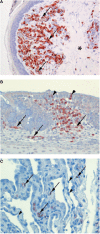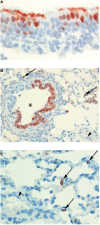Influenza virus and endothelial cells: a species specific relationship
- PMID: 25520707
- PMCID: PMC4251441
- DOI: 10.3389/fmicb.2014.00653
Influenza virus and endothelial cells: a species specific relationship
Abstract
Influenza A virus (IAV) infection is an important cause of respiratory disease in humans. The original reservoirs of IAV are wild waterfowl and shorebirds, where virus infection causes limited, if any, disease. Both in humans and in wild waterbirds, epithelial cells are the main target of infection. However, influenza virus can spread from wild bird species to terrestrial poultry. Here, the virus can evolve into highly pathogenic avian influenza (HPAI). Part of this evolution involves increased viral tropism for endothelial cells. HPAI virus infections not only cause severe disease in chickens and other terrestrial poultry species but can also spread to humans and back to wild bird populations. Here, we review the role of the endothelium in the pathogenesis of influenza virus infection in wild birds, terrestrial poultry and humans with a particular focus on HPAI viruses. We demonstrate that whilst the endothelium is an important target of virus infection in terrestrial poultry and some wild bird species, in humans the endothelium is more important in controlling the local inflammatory milieu. Thus, the endothelium plays an important, but species-specific, role in the pathogenesis of influenza virus infection.
Keywords: endothelial cells; highly pathogenic avian influenza; influenza virus; poultry; zoonotic infection.
Figures


References
Publication types
LinkOut - more resources
Full Text Sources
Other Literature Sources

